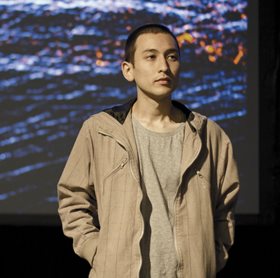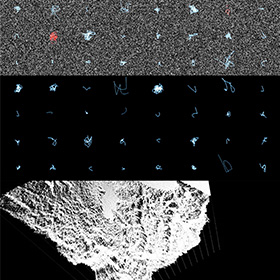 Networks and Collaboration
Networks and Collaboration
Kynan Tan by Perdita Phillips
Just around the corner from the entrance to the State Library are five monitors and two speakers that make up the audiovisual installation Hyperthymesia (25 years of non-linear western australian history) by Kynan Tan. There is a constant stream of fragmented sound that parallels the parade of flickering images on each of the screens. Hyperthymesia is the ability to remember one’s life in intricate detail. The images in this installation were sourced from 260 videos Kynan found on YouTube, all created by Western Australian pop and rock musicians. The music clips have been reduced to fragments of data at 30 frames per second. Memory is lost in hyper-detail. Although fast-paced, the visual images have retained some sort of fleeting coherency, whereas sounds have been reduced to blips without rhythm, melody or apparent variation in pitch.
Kynan frequently works with data in various forms. His background is in musical composition, which has shaped the way that he views the construction of artworks. Combined with an interest in electronic music, there is a strong impression of putting elements together into a greater whole, but which often retains the sense of the ‘atomic’. His works are typified by a finely wrought aesthetic – a delicate ‘plucking’ of data.
 “At the moment I am quite interested in the way that things connect and sort of looking at works and systems as inspiration for artworks but also looking at each artwork as its own network or system…
“At the moment I am quite interested in the way that things connect and sort of looking at works and systems as inspiration for artworks but also looking at each artwork as its own network or system…
in the way that, say, a source like a data source or computer algorithm can then output into multiple different senses and how these relate to each other and inform each other – and can provide inspiration to work in different mediums.”
This approach lead Kynan to expand his media from music and live electronic performance to audio visual installation works such as Hyperthymesia and sculptural installations of his own or in the long-term té project with collaborator Andrew Brooks.
Not surprisingly, the different media and collaborations have allowed Kynan to adopt concepts and approaches of other disciplines and to refine his own sense of what is pivotal to his sound art practice. For té, Brooks is based in Sydney and the duo does a lot of preparation over the Internet before meeting up for focussed and intense project sessions. When working with choreographers, Kynan speaks of adapting to the repetitious nature of rehearsals. In the last year he has had access to a conventional studio space at CIA, which has allowed him consolidated periods of time over weeks to focus on deeper investigations of how image and sound interact.
In Hyperthymesia Kynan builds on the past, not by following methods or trends, but by fracturing and recombining, in order to create something distinctively new. His solo and collaborative investigations into the physicality of perception pose novel questions about image/sound.
Look for Kynan’s work in What I See When I Look at Sound, curated by Leigh Robb and showing at PICA until the end of August. Sound artists in Western Australia have been productive in undoing boundaries. Seeing these creative tensions from other disciplines affords us the opportunity to re-evaluate our expectations about models of art production in Western Australia and take on some of the urgency and adaptability needed for contemporary art in the 21st Century.
Dr Perdita Phillips is an artist working with environmental issues and social change. She is co-editor of Lethologica Press and hopes to be voyaging to the subantarctic later this year.
This article featured in the Artsource Newsletter, Winter 2014.